Ever stood in the produce aisle wondering if you should grab a yellow onion, red one, or maybe even a sweet one? You’re not alone. Onions all bring something different to the table – some are great for slow-cooked dishes, while others shine in fresh salads or quick sautés. Let’s break down the most common types and when to use them so your next dish turns out just right.
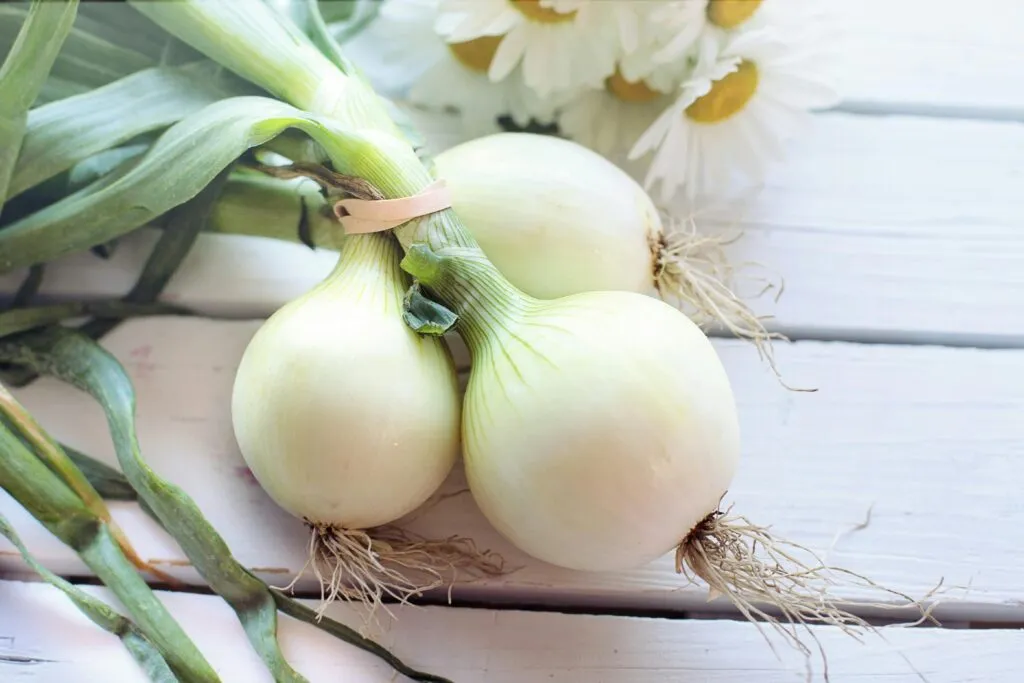
1. Yellow Onion
Yellow onions are among the most commonly used varieties in cooking. They have a balanced flavor that leans slightly sweet but still holds onto a mild sharpness when raw. As they cook, especially over long periods, their flavor mellows and becomes deeply sweet and savory. Their high sulfur content makes them ideal for caramelizing and for adding depth to soups, stews, and sauces. The papery skin and multi-layered structure make them a good all-purpose onion that stands up well to various cooking methods, including roasting, sautéing, and braising. Yellow onions are generally available year-round and are often the default onion in many recipes unless otherwise specified.
Key Highlights:
- Balanced flavor between sweet and sharp
- Becomes sweeter and more mellow with cooking
- High sulfur content helps develop rich flavor in cooked dishes
- Multi-layered, firm structure holds up well in cooking
- Readily available and used in many standard recipes
Best Used For:
- Soups and stews
- Caramelizing
- Roasting with meats or vegetables
- Braises and slow-cooked dishes
- Base for sauces and stocks
2. White Onion
White onions have a sharper and more pungent flavor than yellow onions, especially when raw. Their thin, papery skin covers a crisp interior that holds a lot of moisture. Though they are less sweet than yellow onions, they still cook down nicely and develop a milder flavor when sautéed or roasted. Because of their clean, slightly peppery taste, they’re often used in Latin American and Mexican cuisine. White onions also have a high water content, making them less ideal for long caramelization but excellent for quick cooking and fresh uses.
Key Highlights:
- Stronger, sharper flavor when raw
- High water content
- Cooks to a mellow flavor but less sweet than yellow onions
- Common in Latin American and Mexican dishes
- Crisp and firm texture
Best Used For:
- Salsas and fresh relishes
- Stir-fries
- Topping tacos or burritos
- Quick sautés
- Grilling
3. Red Onion
Red onions are known for their vibrant color and slightly milder flavor compared to white onions. They are often used raw because of their attractive appearance and relatively sweet taste. When cooked, red onions lose some of their vivid color but become more mellow in flavor. They are a common choice for salads, sandwiches, and pickling. While not typically used as a base for sauces or soups, they can still be sautéed or grilled with good results, especially when a touch of sweetness is desired without overpowering heat.
Key Highlights:
- Mild and slightly sweet flavor
- High visual appeal due to purple-red skin and rings
- Loses color during cooking
- Often eaten raw
- Popular in Mediterranean-style dishes
Best Used For:
- Fresh salads
- Sandwich toppings
- Quick pickling
- Grilling alongside meats
- Pasta and grain bowls
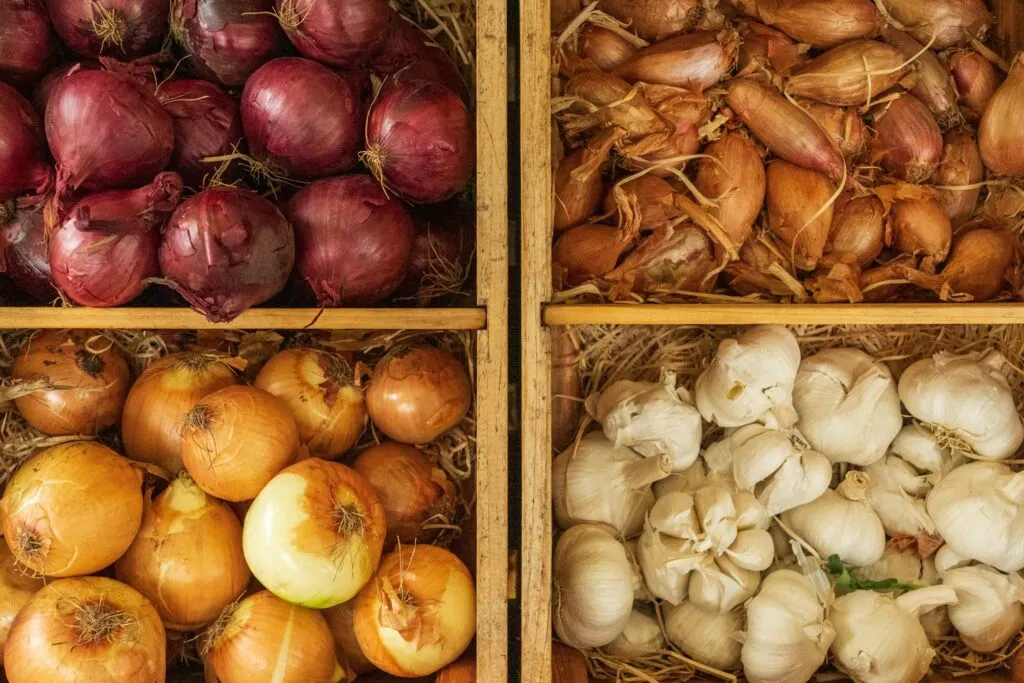
4. Sweet Onion (e.g., Vidalia, Walla Walla)
Sweet onions have a lower sulfur content and higher sugar levels compared to other types. As a result, they taste very mild and almost sugary, even when raw. Varieties like Vidalia (from Georgia), Walla Walla (from Washington), and Maui (from Hawaii) are well-known regional examples. Their crispness and sweetness make them ideal for raw applications, but they also caramelize well, thanks to their sugar content. However, their lower sulfur levels mean they don’t develop as much depth as yellow onions in long cooking.
Key Highlights:
- Very mild and sweet flavor
- Low sulfur, high sugar content
- Best consumed fresh or lightly cooked
- Thin-skinned and high moisture
- Not suited for long-term storage
Best Used For:
- Raw in burgers or sandwiches
- Onion rings
- Grilling
- Light sautés
- Fresh salads
5. Shallot
Shallots are a smaller, elongated type of onion with a mild, subtly sweet flavor that’s less pungent than typical bulb onions. They consist of cloves, much like garlic, and have a purplish hue under their thin papery skin. Because of their delicate taste and smooth texture, shallots are often used in vinaigrettes, sauces, and fine dining recipes where a strong onion flavor might overpower the dish. When cooked, they become rich and slightly sweet, blending well into dishes without standing out aggressively. They are also popular in French and Southeast Asian cuisines for their nuanced aroma.
Key Highlights:
- Mild, sweet, and less pungent than other onions
- Grows in cloves rather than a single bulb
- Cooks quickly and blends smoothly into dishes
- Often used in dressings and sauces
- Common in French and Southeast Asian cooking
Best Used For:
- Salad dressings and vinaigrettes
- Finishing sauces (e.g., béarnaise, pan sauces)
- Stir-fries
- Slow-roasting with meats
- Pickling
6. Leek
Leeks are related to onions but have a much milder and more herbaceous flavor. Only the white and light green parts are typically used in cooking, as the dark green tops are tougher and more fibrous. Leeks have a subtle sweetness and a soft texture when cooked, making them ideal for soups and stews. They don’t have the sharp bite of raw onions, which is why they’re often used in recipes where a delicate onion flavor is desired. Leeks must be thoroughly washed, as dirt often hides in their many layers.
Key Highlights:
- Mild, delicate onion-like flavor
- Softens well with cooking, adding subtle sweetness
- White and light green parts are most commonly used
- Requires thorough cleaning due to soil in layers
- Widely used in various cuisines, including European, Asian, and others
Best Used For:
- Potato leek soup
- Braised vegetable dishes
- Quiches and savory tarts
- Stirred into risottos or pastas
- Stocks and broths
7. Green Onion (Scallion)
Green onions, also known as scallions, have a sharp but mild flavor and are used both raw and cooked. Both the white base and the green stalks are edible and flavorful, although the white part has a more concentrated onion taste. They are widely used as a garnish, in Asian cuisines, and in quick-cook dishes where their light onion flavor enhances without overwhelming. Typically harvested before forming a significant bulb, unlike mature onions.
Key Highlights:
- Edible from base to tip (white and green parts)
- Mild and fresh onion flavor
- Frequently used raw
- Common in many Asian dishes
- Doesn’t form a traditional bulb
Best Used For:
- Garnishing soups and noodles
- Stir-fries
- Omelets and scrambled eggs
- Salsas and dips
- Pancakes and fritters
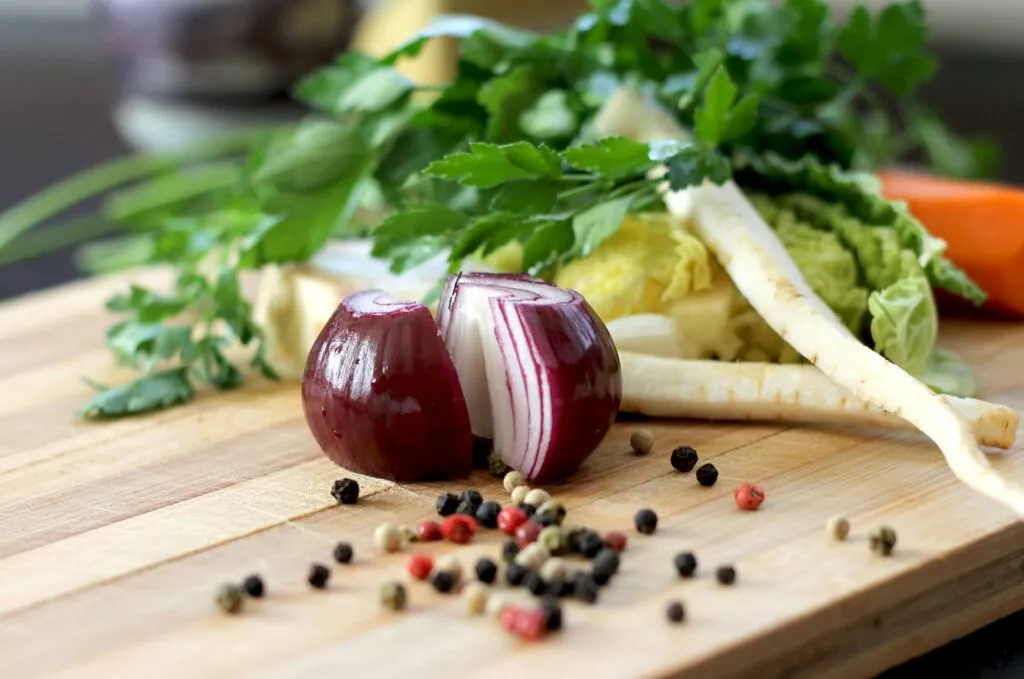
8. Spring Onion
Spring onions are often confused with green onions, but they have a small, round bulb at the base, indicating they’re more mature. They have a sharper, stronger flavor than scallions but are still milder than fully developed onions. Both the bulb and green stalk are edible, and they can be grilled whole or chopped and used similarly to other onions. The bulb’s flavor becomes sweeter when cooked, and the greens offer a nice, fresh finish. Spring onions are often seasonal and slightly harder to find in some markets.
Key Highlights:
- Distinct bulb at the base unlike scallions
- Sharper than green onions but milder than mature onions
- Both bulb and greens are edible
- Can be eaten raw or cooked
- Becomes sweeter when grilled or roasted
Best Used For:
- Grilling whole
- Roasting with vegetables
- Topping flatbreads or pizzas
- Adding to stir-fries
- Soups and broths
9. Cipollini Onion
Cipollini onions are small, flat, and sweet onions with a high sugar content. They are most often used for roasting and caramelizing due to their rich, natural sweetness. Their skin can be a bit tough to peel, but the effort pays off in flavor. When cooked, they become extremely tender and syrupy. Although less common than yellow or red onions, cipollini are popular in Italian and other cuisines, including French and American dishes and make a good choice when a dish calls for sweet, whole-cooked onions.
Key Highlights:
- Small, squat shape with thin skin
- High sugar content
- Becomes very sweet and soft when roasted
- Popular in Italian cuisine
- Tougher to peel due to thin skin
Best Used For:
- Roasting whole
- Braised meat dishes
- Caramelized onion garnishes
- Glazed side dishes
- Onion tarts or galettes
10. Pearl Onion
Pearl onions are small, round onions that typically come in white, red, or yellow varieties. These onions have a delicate, sweet flavor and are often used whole in dishes where their size and subtle sweetness are a key element. They are frequently found in pickled form, as well as in braised dishes or stews where they add a mild, oniony sweetness without being overwhelming. Though peeling them can be a bit tedious, the tender, juicy flesh is well worth the effort in recipes that call for whole onions.
Key Highlights:
- Small, round, and sweet
- Available in white, red, and yellow varieties
- Commonly used whole in dishes
- Mild flavor that adds sweetness without overpowering
- Often used in pickling and braising
Best Used For:
- Pickling
- Braised meats and vegetables
- Stews and casseroles
- Roasted as a side dish
- Glazed onion recipes
11. Maui Onion
Maui onions are a type of sweet onion grown in Hawaii. They are known for their incredibly mild flavor and high sugar content, making them one of the sweetest onion varieties. The Maui onion’s mildness makes it a great choice for raw applications, like salads or sandwiches, where a sharp onion taste might be too overwhelming. These onions also caramelize beautifully and are a perfect addition to dishes like onion rings, salsas, and grilled vegetables.
Key Highlights:
- Extremely sweet with a mild flavor
- High sugar content ideal for caramelizing
- Grown in Hawaii and considered a regional specialty
- Best used raw in fresh dishes
- Less commonly used in cooked savory bases compared to yellow onions but suitable for grilling or caramelizing
Best Used For:
- Raw in salads and sandwiches
- Grilled or roasted
- Onion rings
- Topping burgers and hot dogs
- Fresh salsas and dips
12. Red Torpedo Onion
Red torpedo onions are long, red onions that have a distinctive shape, often resembling a torpedo. They are less pungent than other red onions and offer a mild, sweet flavor with a slightly earthy undertone. These onions are excellent for use raw in salads or as garnishes because of their vibrant color and mild taste. When cooked, they lose some of their color but maintain a sweet, delicate flavor, making them suitable for roasting or grilling.
Key Highlights:
- Long, slender shape with a red hue
- Milder and sweeter than other red onions
- Distinctive flavor with earthy undertones
- Excellent for raw applications
- Loses color when cooked, but flavor remains sweet
Best Used For:
- Raw in salads and sandwiches
- Grilled as a side dish
- Garnishing roasted meats
- Pickled for tacos and burgers
- Adding to salsas and fresh dips
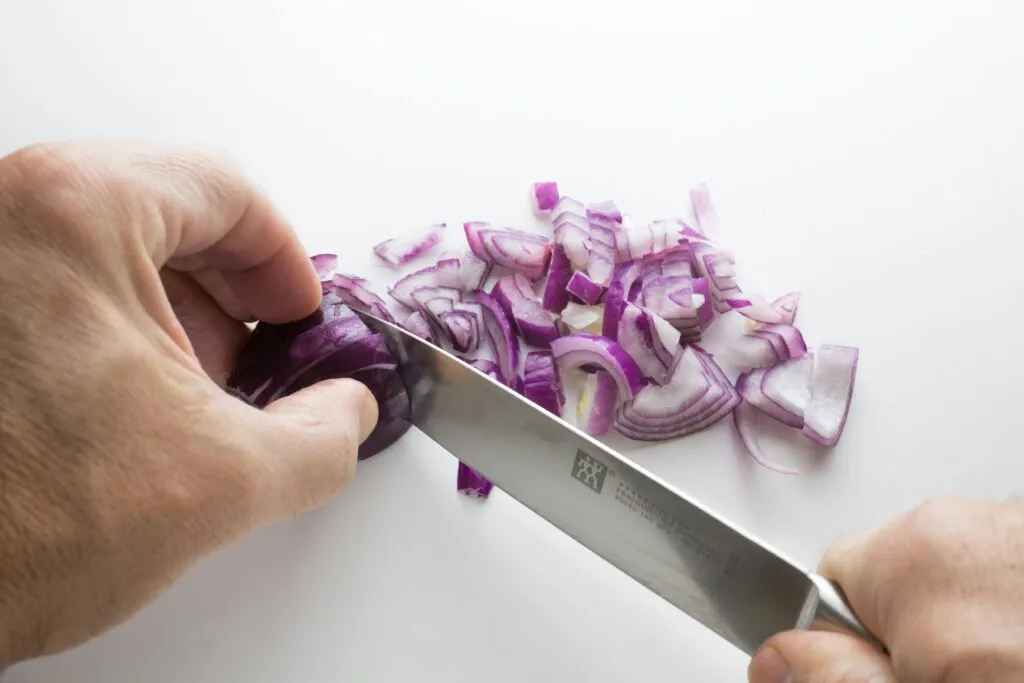
13. Bunching Onion
Bunching onions are a variety of onion that does not form a bulb but grows in clusters of long, tender stalks. These onions are very similar to green onions but have a slightly more pronounced onion flavor. Bunching onions are often used in Korean and Japanese cooking, where they are served raw in salads or as garnishes. The whole stalk is edible, and the flavor is bright, crisp, and perfect for quick-cooking or fresh dishes. Bunching onions are often favored for their mildness and versatility.
Key Highlights:
- Grows in clusters rather than a single bulb
- Similar in flavor to green onions but with a slightly stronger taste
- Entire stalk is edible and used in cooking
- Popular in East Asian cuisine
- Crisp and tender texture when fresh
Best Used For:
- Raw in salads or as garnishes
- Stir-fries and quick sautéed dishes
- Korean pancakes (jeon)
- Topping soups or stews
- Mixed into sushi rice or rolls
14. Brown Onion
Brown onions are often regarded as the “classic” onion variety due to their strong, rich flavor that holds up well during long cooking processes. They have a brown papery skin and white flesh, offering a balance of sharpness and sweetness. When cooked, brown onions become tender and develop a deeper, more savory flavor, making them ideal for creating bases for soups, stews, and sauces. These onions are versatile and can be used in nearly any savory dish, especially those requiring a longer cooking time to develop their full flavor.
Key Highlights:
- Strong and savory flavor
- Becomes sweeter and milder with cooking
- Versatile for many cooking applications
- Ideal for slow-cooked dishes
- Commonly used in soups, stews, and sauces
Best Used For:
- Soup and stew bases
- Caramelizing to add depth to dishes
- Sautéing for sauces
- Roasting with meats and vegetables
- Cooking into curries and braises
15. Vidalia Onion
Vidalia onions are a sweet onion variety grown in Georgia, USA. They are known for their mild, sweet flavor and tender texture. Vidalia onions have a lighter, more delicate taste compared to regular yellow onions and are often eaten raw in salads or used in dishes where the sweetness can be highlighted. They caramelize exceptionally well due to their high sugar content, making them a great choice for dishes like onion rings, onion tarts, or as a topping for burgers.
Key Highlights:
- Sweet and mild flavor
- Lighter and less pungent than regular yellow onions
- High sugar content, perfect for caramelizing
- Grown exclusively in Georgia, USA
- Often used raw in salads or cooked in sweet dishes
Best Used For:
- Raw in salads and sandwiches
- Caramelized in onion tarts or pies
- Grilled as a topping for burgers
- Making onion rings
- Sautéed in sweet sauces or glazes
16. Walla Walla Onion
Walla Walla onions are another variety of sweet onion that grows in Washington state. These onions are large, round, and have a very mild flavor with a noticeable sweetness. Walla Wallas are perfect for raw uses like in salads, sandwiches, and as a garnish. They are also fantastic when grilled or roasted, as their natural sweetness comes out during cooking. Their mildness and tenderness make them an excellent choice for anyone looking for a more subtle onion flavor.
Key Highlights:
- Large, round, and very sweet
- Mild flavor with a slight tanginess
- Grows in Washington state
- Often eaten raw in fresh dishes
- Best when grilled or roasted to enhance sweetness
Best Used For:
- Raw in salads and sandwiches
- Grilled or roasted as a side dish
- Topping burgers and hot dogs
- Pickling for light, sweet flavor
- Using in onion chutneys and relishes
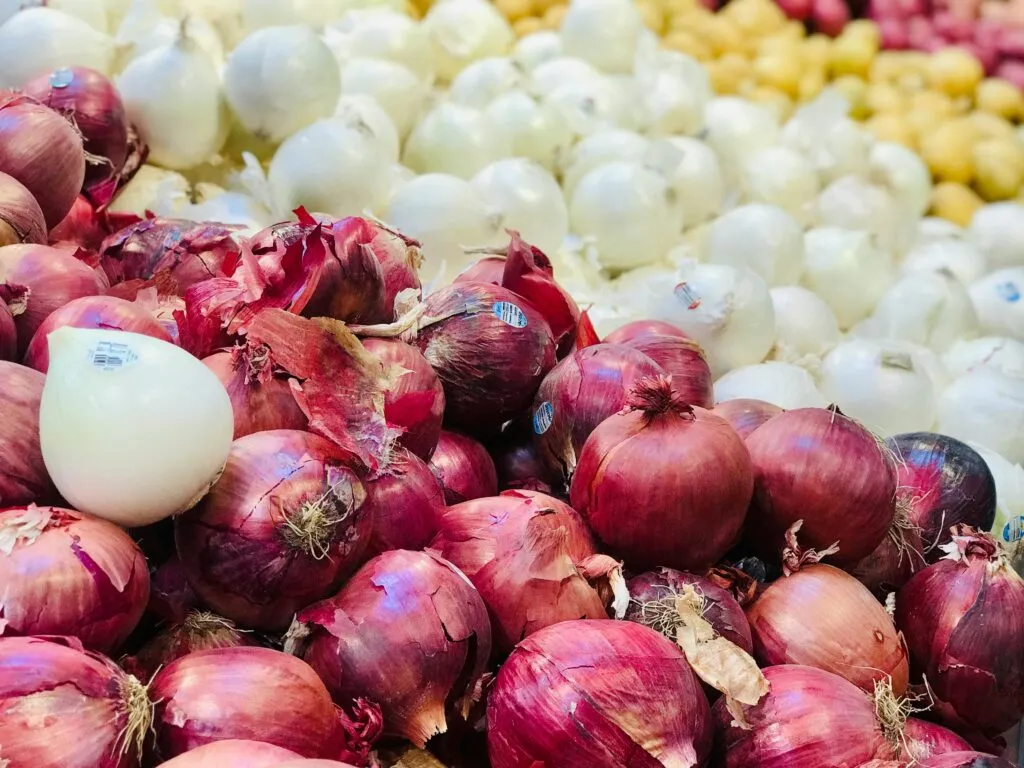
17. Sweet Spanish Onion
Sweet Spanish onions are another type of mild, sweet onion, with large, round bulbs and a very tender texture. Their flavor is much less pungent than regular yellow onions, making them a popular choice for fresh dishes like salads and sandwiches. They are also great when cooked, as they soften beautifully and develop a mild, sweet flavor. These onions are widely available and versatile in both raw and cooked applications.
Key Highlights:
- Large, round, and very mild flavor
- Tender texture when cooked
- Less pungent than yellow onions
- Common in both raw and cooked dishes
- A go-to onion for fresh applications
Best Used For:
- Raw in salads, sandwiches, and salsas
- Sautéed for pasta sauces and stir-fries
- Caramelized for soups and dips
- Grilled as a side dish
- Roasted alongside vegetables
18. Texas Sweet Onion
Texas Sweet onions are another large, mild variety, known for their sweetness and low acidity. They have a very light, delicate flavor that’s ideal for raw applications, such as in salads, salsas, and sandwiches. Their flavor becomes even sweeter when cooked, making them a great choice for dishes that require slow cooking, like stews and braises. Texas Sweet onions are similar to Vidalia onions but are grown in Texas, providing an alternative option for anyone looking for a sweet onion variety.
Key Highlights:
- Very sweet and mild flavor
- Light texture that is ideal for fresh uses
- Grown in Texas, similar to Vidalia onions
- Excellent for slow-cooked and braised dishes
- Popular for use in fresh applications
Best Used For:
- Raw in salads and sandwiches
- Roasted in vegetable dishes
- Grilled as a topping for meats
- Caramelized for soups and stews
- Used in fresh salsas and garnishes
Conclusion
When it comes to cooking, onions are a kitchen staple, and choosing the right one can make all the difference in your recipes. Whether you’re looking for a sharp bite in a fresh salsa, a mellow sweetness for caramelizing, or a colorful addition to a salad, there’s an onion variety to suit every need. From the mild, tender sweetness of Vidalia and Maui onions to the robust flavor of yellow onions, each variety has its own unique taste and texture that can elevate your cooking.
The key is to understand what you’re looking for in your dish – whether it’s sweetness, sharpness, or just a bit of crunch – and pick an onion that complements that. Don’t be afraid to experiment and try different types in various recipes; you might find your new favorite combination. With the right onion, your cooking will have that perfect punch of flavor every time!
FAQ
1. What’s the difference between yellow and white onions?
Yellow onions are typically more pungent and sweet when cooked, making them ideal for dishes that require long cooking times like soups, stews, and roasts. White onions, on the other hand, have a sharper, crisper flavor and are often used raw in salads, salsas, and sandwiches.
2. Can I substitute red onions for yellow onions in a recipe?
Yes, you can substitute red onions for yellow onions, but keep in mind that red onions have a milder and sweeter flavor. They’re best used in raw preparations or light sautés where their color and flavor can shine, while yellow onions offer a deeper, more savory taste when cooked.
3. What onion is best for caramelizing?
Yellow onions and sweet onions, like Vidalia or Walla Walla, are the best options for caramelizing. Their natural sweetness comes out beautifully when slow-cooked, giving you a rich, golden-brown result perfect for burgers, sandwiches, and soups.
4. What are the best onions to use in salads?
For fresh, raw applications like salads, red onions, white onions, and sweet onions (such as Vidalia or Maui) work best. Their milder, crisper flavors add a fresh punch without overpowering the other ingredients.
5. Are sweet onions healthier than regular onions?
Sweet onions, like Vidalia and Maui, tend to have a higher water content and lower acidity compared to regular onions, making them milder and easier on the digestive system. However, nutritionally, they’re quite similar to regular onions and both offer health benefits such as antioxidants and vitamins.
6. Can I use green onions instead of regular onions?
Green onions (also known as scallions) are milder and less pungent than regular onions, so they can be used in dishes where a subtle onion flavor is needed. They work great as garnishes or in raw salads, but if your recipe calls for a deeper onion flavor, it’s best to stick with yellow or white onions.
7. What’s the best onion for stir-frying?
Yellow onions are a great choice for stir-frying because they soften and sweeten as they cook, adding a delicious depth of flavor to your dish. You can also use red onions for a slightly milder taste and a pop of color.
8. Why do onions make you cry, and how can I avoid it?
Onions release sulfur compounds when cut, which irritate the eyes and cause tearing. To reduce the effect, you can chill the onion before cutting, use a sharp knife to make clean cuts, or even try cutting the onion under running water. Some also recommend wearing goggles to keep the irritants out of your eyes.

Leave a Reply